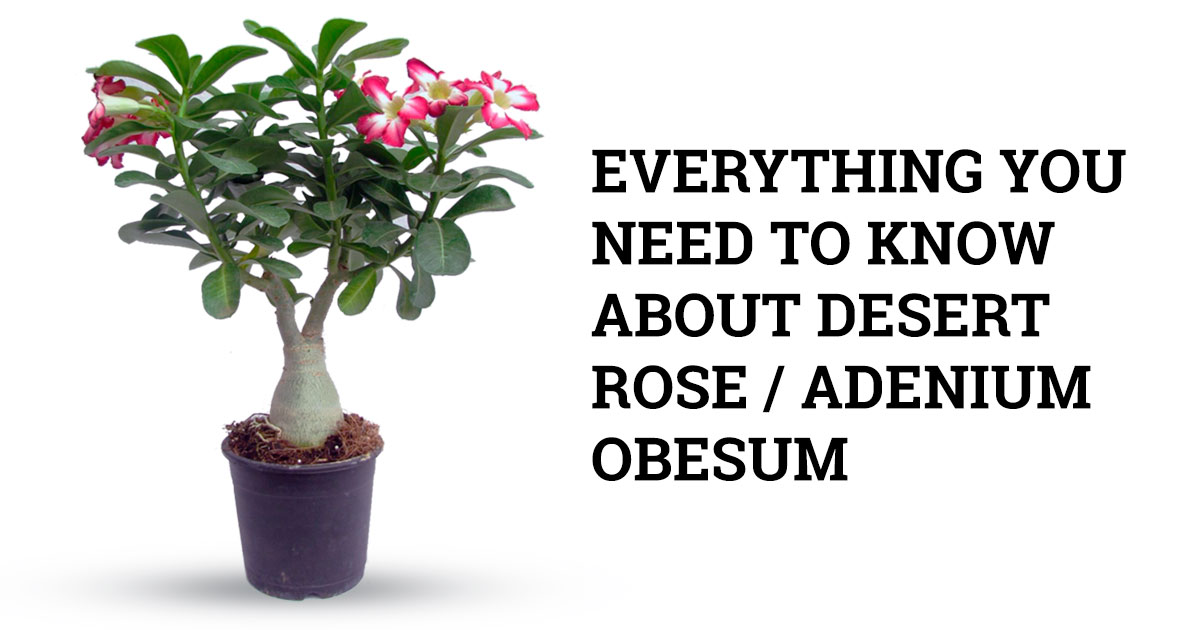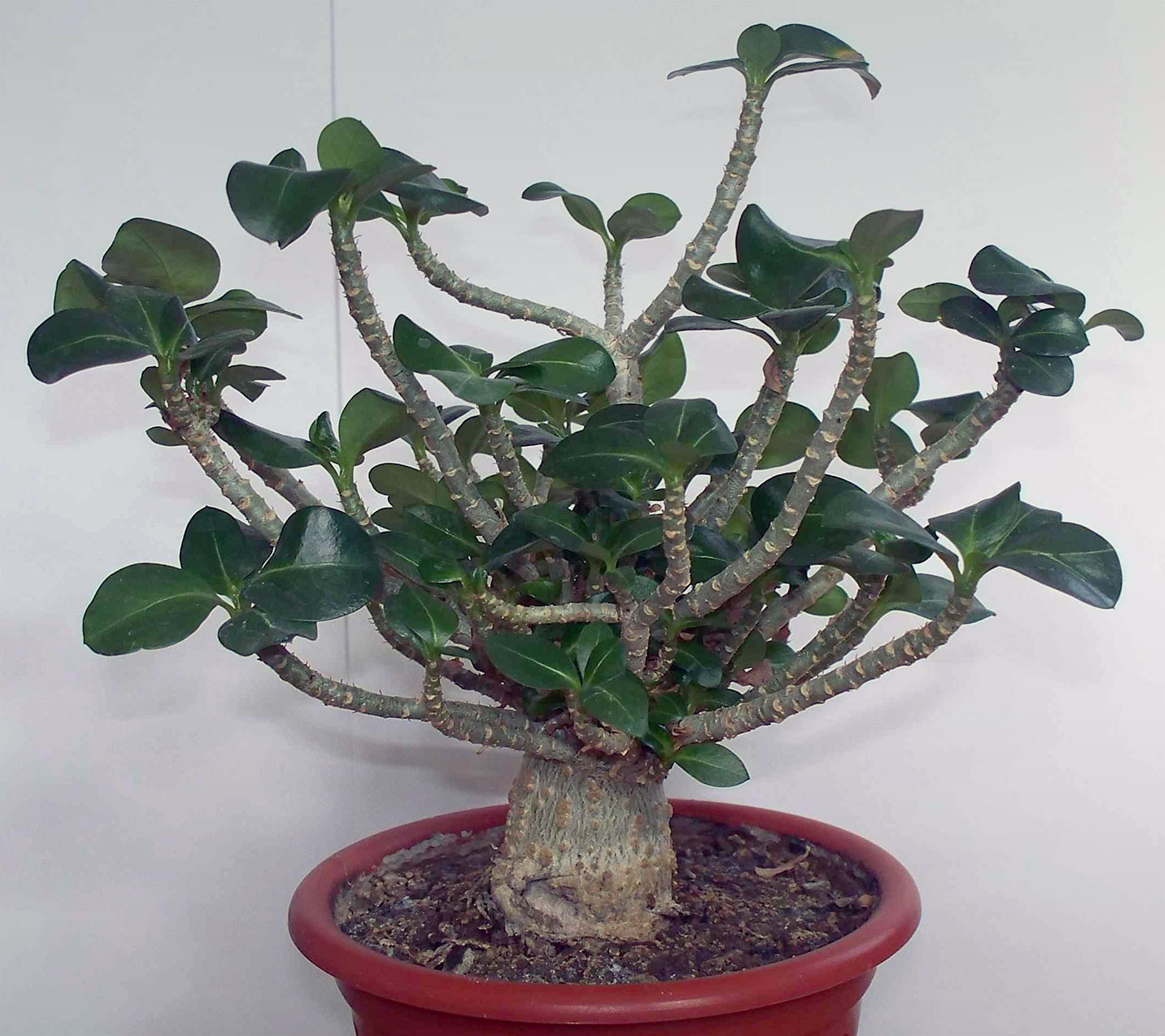When you know what to plant next to this or...
Desert Rose (Adenium Obesum) Plant Care Guide
Adenium desert rose is widely known by its deep red flowers and a swollen succulent stem. It is frequently referred to as Adenium Obesum, the plant which growth mainly depends on pruning and variety. Be very careful with the sap of Adenium desert rose, as it is poisonous and should not come into contact with pets and children.
When desert rose, or Adenium Obesum, grows on its own, it can reach 10 feet, though there are common cases, when the plant reaches 15 feet. To ensure that the plant has enough soil for proper growth, it should be repotted in a large container. New growths can be pruned and the plant can be easily shaped during the time of its most active growth (during spring and summer months).
Desert Rose: Plant Care Guide
Adenium Obesum, or Desert Rose, is one of the most magnificent and flowering plants. This is a shrub or a small tree with a fleshy trunk that grows slowly. Adenium Obesum prefers desert and tropical climates. In nature, Adenium Obesum grows in the Arabian Peninsula and the area from Senegal to Sudan and Kenya.
Adenium Obesum is an evergreen deciduous plant, a feature of which is drought resistance. During the cold season, Desert Rose, like most deciduous trees, can shed leaves. In the summer season, the plant is usually covered with many flowers, collected in corymbose inflorescences. Flowers of Adenium Desert Rose plant have five petals, they are tubular, red or pink with a smooth transition to white.
Adenium Desert Rose is an unpretentious and early flowering plant. It’s quite simple to care for Adenium Obesum Desert Rose indoor flower. The plant needs a sunny place and high air temperature in summer and at least +10°C in winter, as well as watering regime similar to a cactus. So, as you can see, it doesn’t take much time and effort to care for Adenium Obesum.
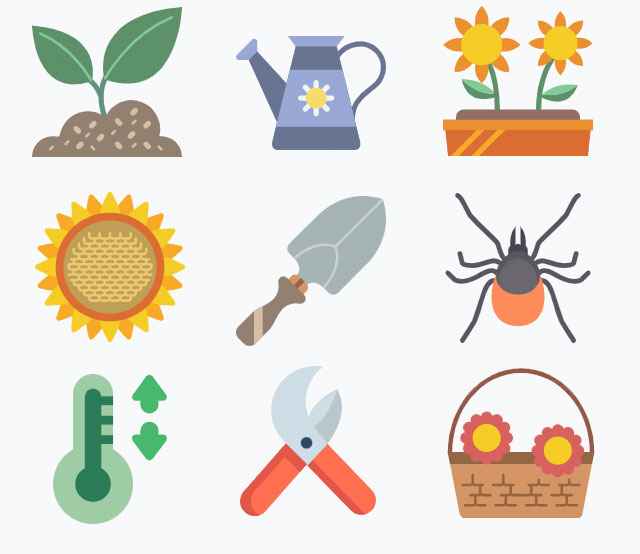
How to care for Adenium Desert Rose indoor plant
If you decide to get Adenium Obesum, then the most simple way is to grow it from seeds. Such specimens of Desert Rose are the closest to the plants growing in the wild. Subject to all the necessary conditions, a small miracle will quickly turn into a full-fledged flowering plant.
Lighting
The more sun, the better life for Adenium Obesum! This is the key to the rapid growth of wonderful looking Desert Rose plant. It receives the strength for full flowering only with the maximum possible lighting.
Watering
When watering Adenium Obesum, make sure that the soil is completely wet. Allow the soil to dry properly between waterings. During the summer (vegetative period), Desert Rose needs more water, do not let the soil dry out during this time of the year, since the plant can stop its growth. At the same time, when taking care of Adenium Obesum, you should not overdo with watering, so that the rhizome does not rot.
When the autumn begins, it is worth gradually reducing the amount of watering, since Adenium Obesum enters the dormancy period. In winter, the flower should be watered rarely, in order to avoid decay processes.
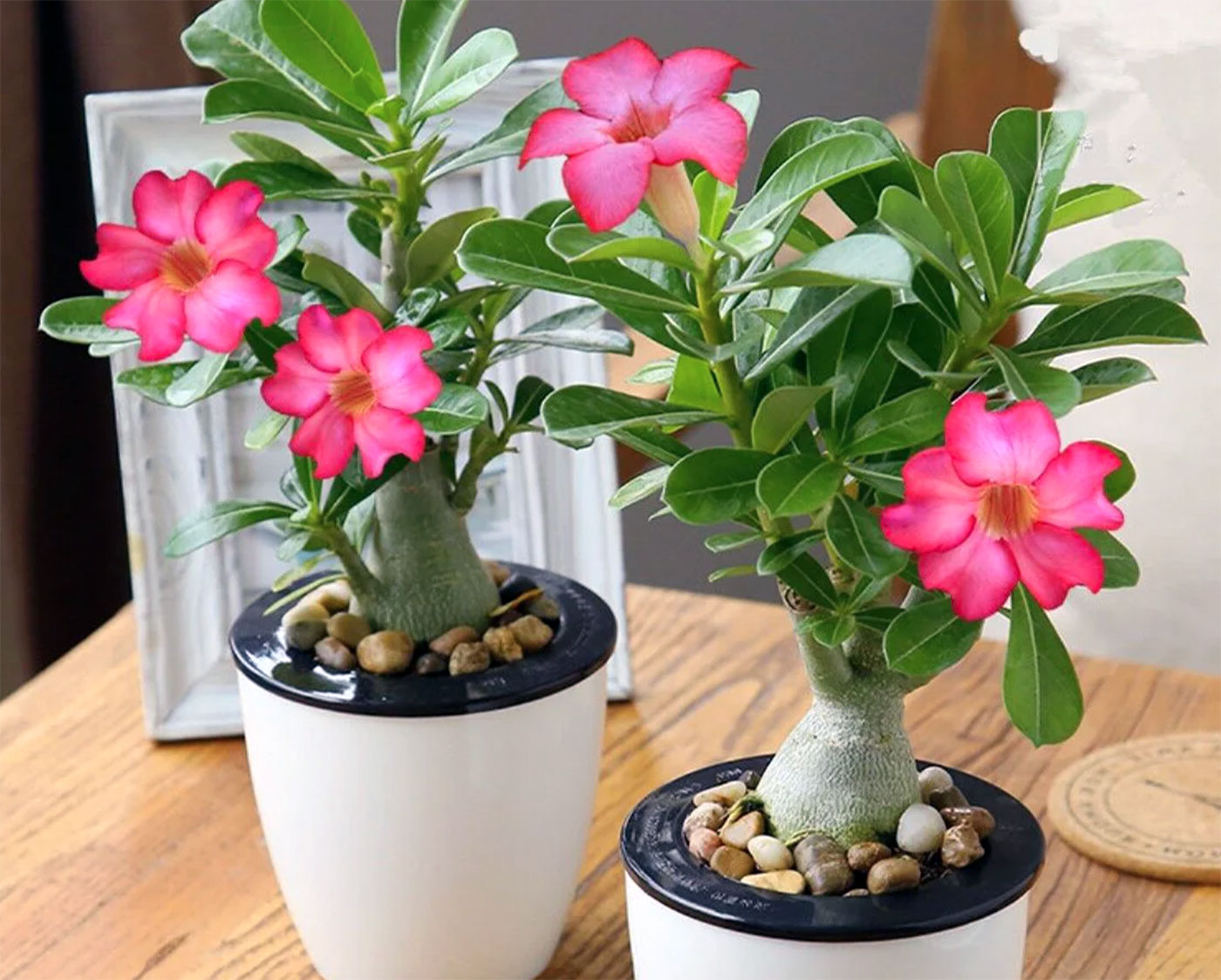
Soil and Pots
If you decide to purchase an adult Adenium Obesum plant, prepare for its repotting. To repot a Desert Rose, you need nutritious, loose and permeable soil, preferably with the addition of charcoal. The soil mixture for Adenium Obesum should also contain:
coconut fiber - 50%
deciduous-humus soil - 20-30%
perlite - 10-20%
small, up to 3 mm expanded clay-10-20%
A pot for Desert Rose should not hold water, there should be the holes at the bottom of the pot for excess water. The pot should be slightly larger than the rhizome of the Adenium Obesum flower. Bowl-shaped pots are perfect for Desert Rose plants.
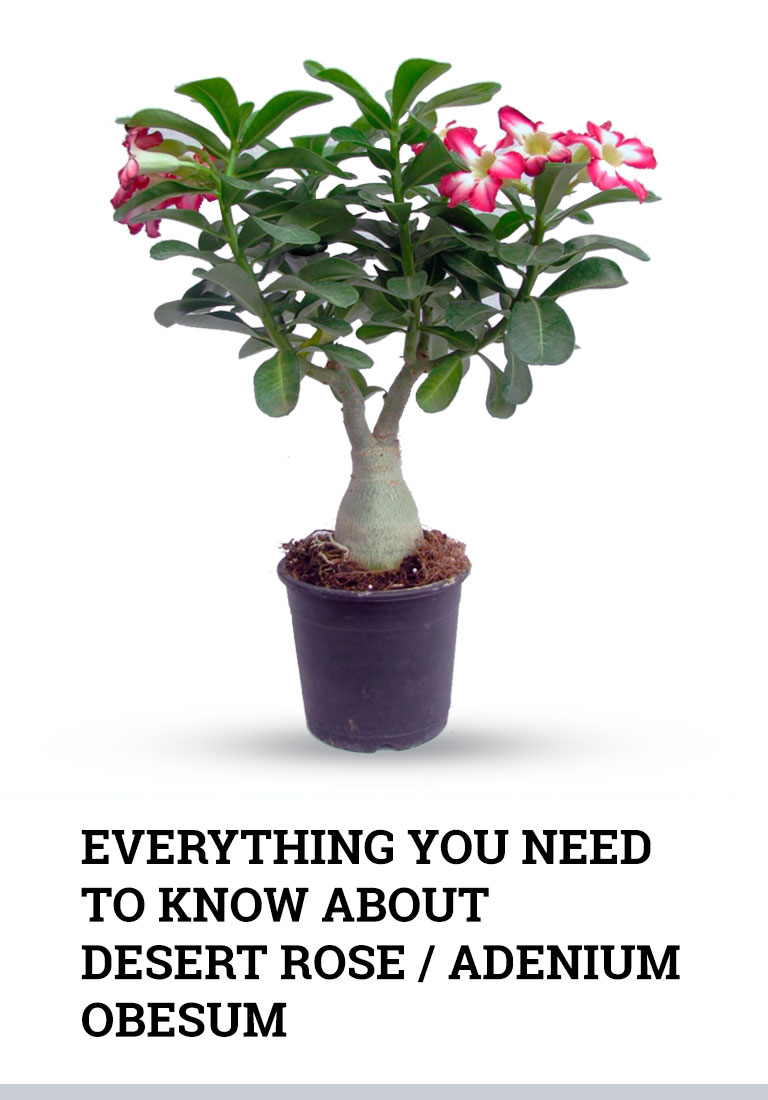
Fertilizer
Adenium Obesum care is impossible without using fertilizers. You can use soluble fertilizers or feed the plant with organic-mineral solutions with the same proportions of phosphorus, potassium, nitrogen. Fertilizers with increased nitrogen have a positive effect on Adenium Obesum during the growing season. Remember, that such fertilizers should not be used for Adenium plants often, but mainly at the beginning of the growing season.
Desert Rose: How to care for the plant in winter?
The winter period is one of the most difficult in the life of Adenium Obesum. This time of the year is a dormancy period for Desert Rose: the leaves almost completely fall off, the plant doesn’t need constant watering. Adenium Obesum care during the winter is a little more complicated, since the flower needs perfect conditions for maintaining vital processes:
Temperature about +10°C +15°C (50°F - 60°F)
Moderate watering and only on warm days
Do not overdo with watering. An adult plant which has thrown off the leaves should be watered once a month
Determine the end of dormancy period in time. To do this, it is necessary to move Adenium Obesum to a bright place and check when the buds appear. I start watering 2 to 3 weeks after the end of dormancy period.
Adenium Desert Rose Diseases
The main danger for Adenium Obesum is decay processes in the root system. That is why Adenium Obesum doesn't need to be watered too much. A drainage layer is a must for a greater guarantee! Among other things, Adenium Obesum plants are susceptible to attack by insects (mealybugs, ticks, etc.) and even the toxicity of Desert Rose sap does not help to protect the plants.
If you face such a problem, you need to fight by generally accepted and all known methods. When using new methods and technologies, check them on the least valuable Adenium Obesum specimen first.
Toxicity
Adenium Desert Rose contains poisonous sap, so, after work with the plant is over, thoroughly wash your hands with soap. The flower should stand in a place that is inaccessible to animals and children. If you decide to decorate your home with Adenium Obesum, then this must be taken with full responsibility in order to avoid poisoning.
Remember that Adenium is toxic to both cats and dogs. Do not allow your pets chew the leaves of the plant. It can cause weakness, vomiting and indigestion. At the first signs of poisoning, immediately bring your pet to a veterinarian. See more about pets and the effect toxins have here at the ASPCA.

Desert Rose Propagation
Adenium Obesum, or Desert Rose plants, propagate in different ways.
Many Adenium owners are familiar with the situation when, after the formation of the crown of Adenium Obesum or when the plant is damaged by rot, they get cuttings. Especially if it is a rare variety of Adenium, the owners wonder how to use the cuttings for Adenium Obesum propagation. In these cases, there is a simple and reliable way to save the plant - propagation of Adenium by cuttings.
To succeed in rooting Adenium Obesum cuttings, the most favorable period is the middle of the summer, when it is easy to create perfect conditions: plenty of sunlight and heat. This time of the year helps to avoid additional heating and lighting. But if, for example after spring pruning, you get healthy and strong cuttings, you can also use them to propagate Adenium at home.
For rooting you need a soil that allows air to pass through well. There can be several soil options:
river sand - 2 parts; coconut fiber - 2 parts; perlite - 1 part
or perlite - 3 parts; coconut fiber or sphagnum moss - 1 part
or in pure perlite, vermiculite
Take the cuttings from a healthy, mature plant in the active growth season. To cut them, use a sharp and disinfected knife or blade to make the edges of the cutting even, without torn areas, without damaging the plant tissues.
The average size of cuttings for successful rooting is 10-15 cm, but based on practice, under perfect conditions, short Adenium cuttings (3-5 cm) and longer cuttings (15-20 cm) also root well. There should be no leaves on the lower part of the cutting. Leaves may be left at the top, as they take part in activating processes in the cuttings, including the formation of roots. Without the leaves, rooting occurs with frequent rotting. The leaves that the stalk cannot support will fall off on their own.
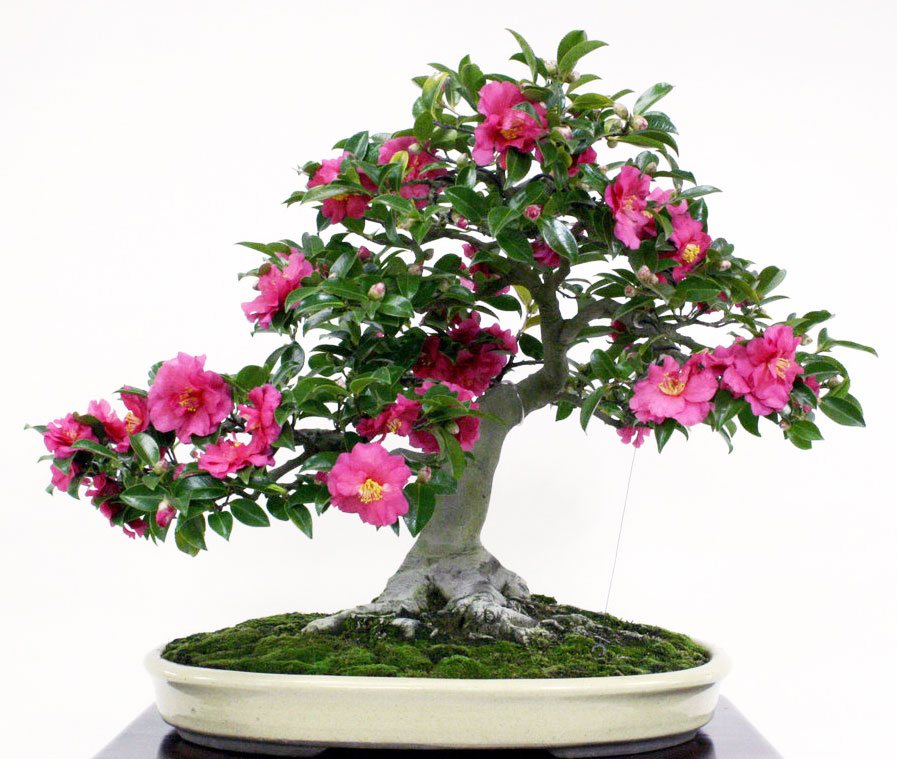
The cut must be dried until the sap stops. Young, thin cuttings start to fade with long drying, the leaves fall off. This leads to decay of the planting material.
You can additionally treat the cut with a root former. It’s good because such solutions do not contain vitamin supplements and fertilizers that provoke rotting of the cuttings. But even without the use of a stimulant, the rooting rate does not decrease.
For rooting cuttings in the substrate, choose a medium-sized pot with loose soil. Deepen the cutting into the soil to a depth of 4-6 cm. Cover the pot with the cuttings with cling film or a plastic bottle. Place the pot on the south window, shading it from direct sunlight.
An important condition of taking care of Desert Rose cuttings is keeping the soil in an evenly moist state. The substrate should not be wet or dry. When the soil mixture dries up, moisten it with soft, well-settled water, without any additives. Roots actively develop at the temperature of +25°C +35°C. At lower temperatures of water and soil, the time of root formation increases and there is a high risk of rotting of the cuttings. Extra heat is needed for this way of Desert Rose propagation if the air temperature is lower than +25°C +35°C.
Indoors, Adenium Obesum forms roots in 0.5-2 months. A sign of roots formation in a plant is the new leaves. Then the cuttings can be repotted to a permanent place.
The method of rooting Adenium Obesum cuttings in water is no less popular. For this, you should use filtered soft water and add 1 drop of root former to 150-200 ml of water. Make cuts in the form of a cross, it will activate root growth. Keep the water in the container constantly warm. Put the container in a warm place, and if necessary, heat it. Add water every day, and once every 7 days, completely change it. Thick shoots, more than 12 cm long, form roots in 12-16 days if all conditions are met.
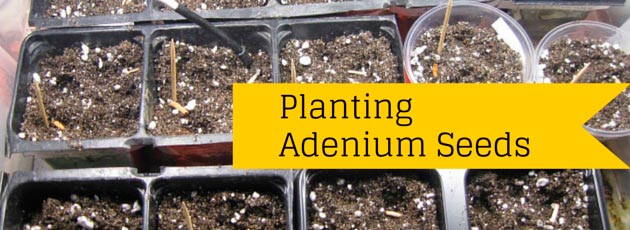
And of course another popular way of Adenium Obesum propagation is growing from seeds. If you need to get a lot of plants, then it is better to propagate Desert Rose by seeds.
Seedlings usually appear on the 3rd day after sowing. The perfect conditions for seedlings to appear are: the temperature of +30°C +35°C, air permeability of the soil, moderate watering, long-term lighting - 16 hours a day. Put the seeds into the soil to a depth of at least 10 mm. Before planting,disinfect the soil with a weak solution of potassium permanganate.
The soil for Desert Rose seeds to grow should be taken from 50% of the soil mixture for cacti or succulents and 50% of baking powder such as perlite, river sand, charcoal. This type of the soil is well structured and does not compact after watering. Charcoal disinfects the soil around the roots.
After all the seeds have germinated, the heating can be removed, and the seedlings can be moved to the south window shaded from the direct sun.
For seedlings grown at home, at the age of 1-2 months, you can additionally feed them with a mineral complex containing nitrogen, potassium and phosphorus in equal proportions. The appearance of two true leaves is a guideline for repotting the seedlings into an individual pot.
Pros and cons of propagation by seeds and by cuttings:
Propagating Adenium Obesum, or Desert Rose, in different ways, either growing from seeds or by cuttings, have its pros and cons. With seed growing, seedlings are less prone to rot, but you have to wait for flowering for 2-3 years. When propagating by cuttings, there is a high risk of decay of the planting material, but with a positive result, the plant can start flowering two times quicker.
As you can see, caring for Adenium Obesum plant at home is quite simple and at the same time painstaking work. But the result will not keep you waiting long. If you follow the recommendations and tips of how to care for Desert Rose, you can easily grow a real masterpiece that will certainly please the eye.
About the Author
My name is Michael Bauer, I have been growing and taking care of plants for 20 years. My dream has become a reality. I've had many difficulties along the way, but my love for our favorite plants has really helped me.So join us!







